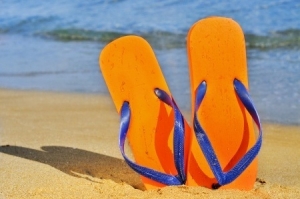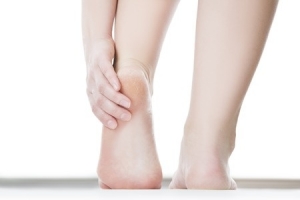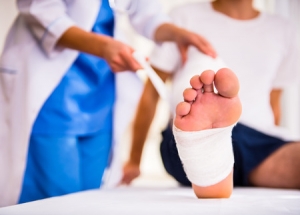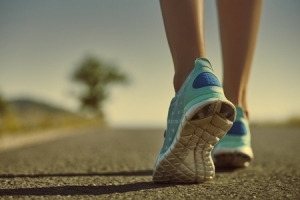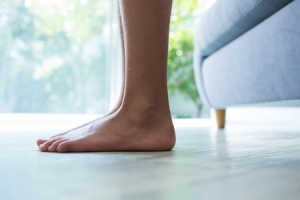Connect With Us
Blogs
Displaying items by tag: plantar fasciitis
Resolve to Get in Shape—Safely
Is starting a new fitness plan one of your New Year’s resolutions? At Superior Foot & Ankle Care Center we applaud this initiative, but also add a word of caution. We see too many patients who fail to take the necessary steps to ensure that their new fitness plan is safe. Prevent injuries and get your healthy resolution off to a smart start by taking into consideration the following.
Your Current Condition—do you suffer from any chronic foot or ankle disorders such as flat feet, plantar fasciitis or hammertoes? Our podiatrists, Dr. Victoria Foley or Dr. Constance Ornelas, can help you determine the best type of exercise and footwear to accommodate an existing podiatric condition. In some cases, special padding or even a custom orthotic device may be prescribed to make exercise more comfortable.
Long-term Goals—in order to determine the type of exercise to do, you need to know what your goals are. Do you want to lose weight? Have more strength and endurance? Improve flexibility and balance? Your general physician and exercise professionals can help match your goals to fitness activities and sports that will best achieve them.
Gear—in our opinion, your footwear is the most important piece of equipment for a new fitness program. Be sure that you get the right shoes for your sport and that they fit properly. If the foot doctor has recommended an orthotic, be sure it fits in your sports shoes. Look for socks that are not too bulky and ones that wick moisture away from your skin to prevent athlete’s foot and fungal infections.
Now you’re ready to begin. Start slow and gradually increase the degree of difficulty of your work out. If your feet or ankles hurt from your new exercise plan, contact our Long Beach office for an appointment by calling: (562) 420-9800.
Free Your Feet from Shoes that Hurt
Freedom is a word frequently associated with Independence Day and here at Superior Foot & Ankle Care Center, it’s also a reminder that many patients are wearing shoes that too small for their feet. Improperly fitting shoes is one of the top causes of foot pain and can lead to chronic foot disorders such as plantar fasciitis and fallen arches. Follow the tips below on your next shoe shopping trip to ensure a good fit:
- Don’t buy shoes without trying them on. Even if you think you know your size, fit can vary based on the manufacturer and the shoe style.
- Get your foot professionally measured. There are two good reasons for this. First, most people have two different sized feet. You’ll want to buy shoes to fit the bigger foot. Also, your shoe size may increase as you get older or if you’ve recently given birth.
- Shop at the end of the day. Your feet are at their largest and most swollen after you’ve been on them all day. A common foot shopping faux pas is buying shoes early in the day and then finding when you wear them that you can’t wait to take them off at the end of the day because they make your feet hurt.
- Focus on the toes. Many common toe problems such as bunions, hammertoes, ingrown toenails, and corns are made worse by shoes that have narrow toe boxes. High heels can also force toes into a cramped position. You should be able to wiggle all your toes freely in a properly fitting pair of shoes and there should be at least a half an inch of space between your longest toe and the front of the shoe.
- Avoid styles that are completely flat with no arch support. In addition, if the foot doctor has prescribed an orthotic device, bring it with you and try on with the shoes you are considering.
- Try on both shoes and take your time walking around the store to make sure they are comfortable. When you take the shoes off, check for red marks on your feet which may indicate friction or rubbing from the shoe.
If you are experiencing chronic foot aches and pains, schedule an appointment at our Long Beach office by calling: (562) 420-9800. Our podiatrists, Dr. Victoria Foley or Dr. Constance Omelas will evaluate your feet and determine whether it’s your shoes or another problem that is causing your discomfort.
Flip-Flop Fail
They’re so easy to wear—just slip them on and off you go. In flip-flops your feet feel so free, as if there’s hardly anything there and that’s the problem! There isn’t. At Superior Foot & Ankle Care Center we know many of our patients love flip-flops and wear them nearly every day but unfortunately, it’s a shoe choice that can leave your feet vulnerable to injury and result in serious foot problems. Here’s why:
Increased Risk of Injury—let’s start with the obvious: flip-flops provide very little protection for your feet. Since they are so exposed, your toes are not shielded from getting stubbed and cuts can happen when your foot slides off the shoe. In addition, because there are no sides to hold your foot in place, flip-flop wearers are more likely to sprain an ankle.
Toe Stress—think about the motion required to keep flip-flops on. Your toes are constantly gripping the front of the flip-flop. With extended use, the strain to the toes can cause tendonitis and toe deformities such as hammertoe and bunions.
The Fracture Factor—with literally no cushioning, flip-flops offer zero shock absorption as you walk. The repetitive pounding on the bottom of your foot and lack of arch support can result in stress fractures, heel pain and plantar fasciitis. You may also find that you experience pain in your ankles, knees, hip and back because of the altered gait that comes about with prolonged flip-flop use.
Finding a Better Flip-Flop
Due to the popularity of this type of footwear, some manufacturers have begun to make shoes that offer the easy style of flip-flops but with an eye to lessening the damage to your feet. If you are frequent flip-flop wearer, look for the following
- A built-up centerpiece for arch support
- Flip-flops made of leather instead of plastic or vinyl to reduce blisters
- More substance—if you can bend a flip-flop completely in half it does not have enough cushioning or support
- A back strap
If you’ve been wearing flip-flops as your go-to shoes for a long time now and are experiencing pain in your ankle, toes, heel or forefoot, make an appointment at our Long Beach office by calling: (562) 420-9800. Our podiatrists, Dr. Victoria Foley or Dr. Constance Omelas will examine your feet and make specific recommendations about shoe choices that will be the healthiest for your feet.
5 Causes of Heel Pain
When your heel hurts, we at Superior Foot & Ankle Center know how limiting that can be on your day to day life. When every step is painful it’s difficult to walk, let alone work, shop, take care of children and household tasks or do any of the many other activities we normally take for granted. While resting your foot may temporarily ease heel soreness, permanent relief requires discovery of the source of the pain and developing a treatment plan that will address the root cause. Below are some common reasons for heel pain:
- Plantar fasciitis/heel spurs—this disorder is one of the most frequent reasons why patients experience heel pain. It occurs when the plantar fascia—a long band of tissue that stretches from your toes to your heel on the bottom of your foot—becomes injured or inflamed. If a patient is prone to plantar fasciitis they also have a greater likelihood of developing heel spurs, which are calcium deposits that build up in the heel and cause additional pain.
- The Wrong Shoes—sometimes eliminating heel pain is as simple as changing your shoes. Shoes that don’t provide adequate arch support or that position your foot in an abnormal way can inadvertently put extra pressure on your heel.
- Arch Issues—having flat feet or high arches alters the correct alignment of your feet with heel pain as a possible result.
- Calluses—these patches of hard, dry skin that appear on the surface of your heel are actually a sign of an internal irritation. The excessive pressure put on the heel by wearing high heels, being overweight, an altered gait or even the loss of the natural fat padding on your heel can all cause heel irritation which reveals itself in the callus.
- Nerve Problems—with disorders such as tarsal tunnel syndrome or Baxter neuropathy a compressed nerve in the foot or ankle can produce excruciating pain in the heel. If the pain is felt in both heels there is also a chance that the nerve issue is further up in the body in the spinal column.
Our podiatrists, Dr. Victoria Foley and Dr. Constance Ornelas will need to do a complete examination of your foot, ankle, and heel to diagnose the source of your heel pain. X-rays and other imaging studies may also be ordered. Once a diagnosis is confirmed, the foot doctor will be able to prescribe the correct treatment plan to resolve your heel pain. If you are experiencing pain in your heel, contact our Long Beach office by calling (562) 420-9800 today.
3 Ways that Food Affects Your Feet
At Superior Foot & Ankle Care Center we know that the condition of your feet isn’t just about what goes on below your knees. Our podiatrists, Dr. Victoria M. Foley and Dr. Constance Ornelas believe that the health of the rest of your body plays a significant role in podiatric concerns. In honor of National Nutrition Month, we want to highlight the importance of proper eating and how it relates to your feet. Below are 3 ways that your diet can improve the health of your ankles and feet.
- Avoid Diabetes—diabetes, which afflicts over 30 million people in the U.S., affects your body’s ability to properly use or produce insulin resulting in high blood sugar levels. Diabetes reduces circulation and can cause neuropathy (loss of sensation) leaving your feet vulnerable to wounds and ulcers that can lead to infections and even possible amputation. The good news is you can prevent or significantly delay the onset of the most common form of this disease, Type 2 diabetes, with physical activity and modifications to your diet, including:
- Cutting way back on foods high in added sugar such as sodas and refined, processed foods
- Increasing the number of fruits, vegetables and whole-grain foods you consume every day
- Switching to healthier sources of fat such as olive and canola oil, nuts and avocados and avoiding saturated fats
- Prevent Gout Attacks and Inflammation—for patients who suffer from gout food is often what triggers an attack. Avoiding shellfish, red meat, beer, red wine, organ meats and heavy sauces can help you steer clear of this extremely painful joint inflammation which often happens in the big toe or ankle. Inflammation in, general, can be reduced by eating more berries, fish, and nuts high in omega 3 fatty acids, green vegetables, and olive oil, while steering clear of white sugar, fried food and refined flours.
- Decrease Your Risk of Foot Disorders—what do arthritis, plantar fasciitis, stress fractures and flat feet all have in common? The risk of developing one of these podiatric disorders as well as the severity of their symptoms are all increased by being overweight. There are many strategies for reducing and maintaining a healthy weight:
- Using smaller plates to automatically reduce portions
- Consulting a nutritionist or registered dietician to develop a healthy food plan
- Eat smaller portions more frequently instead of big meals
If you have questions about how changing your diet could impact a chronic foot condition contact our Long Beach office at 562-420-9800.
Post Op Pointers for Speedy Healing
At Superior Foot & Ankle Care Center we are committed to helping patients obtain relief from foot and ankle disorders using the least invasive methods possible. Sometimes, however, when conservative methods fail to give good results or a condition has progressed to a certain point, surgery is the best treatment option. Whether your surgery is to correct a bunion or help with flat feet, plantar fasciitis or another podiatric condition, what happens after the surgery is critical to completing the healing process. Below are some areas you should focus on if you are planning or have recently had podiatric surgery:
Plan Ahead—our feet are so crucial to daily living and yet we often take them for granted. If you will be unable to walk, even for a short period of time, you will need to put certain things into place prior to surgery:
- See that the area where you will be recovering has everything in easy reach—T.V. remote, books, water, phone, etc. If you sleep upstairs, you may need to set up a temporary bedroom on your main floor.
- Accept all offers of help for meals, running errands or caring for children.
- Clear your calendar of work and other appointments and obligations. Regardless of mobility, you will need rest immediately after surgery.
Wound Care—one of the most critical aspects of surgical recovery is preventing an infection from developing. Be sure you understand and follow all your foot doctor’s instructions for keeping surgical wounds clean. If you notice any signs of infection—warmth at the site of the surgery, redness or red streaks around the wound or fever—contact our podiatrists, Dr. Victoria Foley or Dr. Constance Omelas, immediately, even if it is after regular office hours.
Follow Through—don’t be your own foot doctor! Follow all of the podiatrist’s guidelines for your recovery and complete the full course of any physical therapy that is prescribed. Too often patients will discontinue therapy when they are feeling pain-free, but particularly for foot and ankle injuries strengthening of surrounding muscles and ligaments is necessary for full recovery. If you have any questions concerning post-operative care instructions or symptoms you experience after surgery don’t hesitate to contact our Long Beach office by calling: 562-420-9800.
Walk Your Way to Better Heart and Foot Health
February is American Heart Month and we at Superior Foot & Ankle Care Center want to encourage an activity that will benefit your heart as well as your feet: walking. According to the American Heart Association, brisk walking can lower your risk of diabetes, high blood pressure, and high cholesterol—three factors that greatly increase your risk of heart disease. All of these types of disorders can negatively impact your circulation. With your feet being the part of your body farthest from your heart, circulatory issues are particularly important to good podiatric health. In addition, walking helps you maintain a healthy weight—another plus for protecting your heart and your feet. So, what are you waiting for? Below are a few tips to help you get started.
- Start with good shoes. Walking is appealing because it doesn’t require a lot of expensive equipment and you can do it practically anywhere. The one thing you do need, however, is a good pair of shoes. It’s best to get your feet professionally measured at a shoe store that specializes in athletic footwear. If you have an existing foot disorder such as bunions or plantar fasciitis, talk to one of our podiatrists, Dr. Victoria Foley or Dr. Constance Omelas to learn about designs that will best accommodate your condition. The foot doctor may prescribe an orthotic device to improve comfort and function of your feet.
- Pace yourself. While 30 minutes a day is the goal, every step puts you on the path to better health. If you’ve been sedentary for a while it’s a good idea to start small and gradually increase the speed and length of your walks. Can’t find 30 consecutive minutes? Take two 15-minute walks. Look for ways to sneak in extra steps: walk while you talk on the phone, park farther away from the office or stores, take the stairs instead of the elevator or escalator.
- Make it enjoyable. Walk and talk with a friend, watch your favorite television series while on the treadmill or make walking a bonding opportunity with your teenager. You are much more likely to stick with an activity if you like it.
Within a short time, your walking program will begin to pay off. Not only will your heart and feet be healthier, you’ll sleep better and be more focused during the workday. If you have additional questions about walking and your feet, contact our Long Beach office by calling: 562-420-9800.
Avoiding Common Pediatric Foot Problems
At Superior Foot & Ankle Care Center we find that most children’s podiatric issues result either from poor hygiene habits or overuse injuries related to sports activities. One of the difficulties in diagnosing and treating children is that they are not always able to articulate their symptoms or even identify the source of discomfort. Look for these indicators that your child may be experiencing foot or ankle pain:
- Limping or walking or running in an abnormal way.
- Not wanting to participate in sports or other active pursuits that they normally enjoy.
- Complaints of tiredness.
- An increased frequency of trips and falls.
If your child is showing any of these signs inspect their feet completely (but gently—the cause of the pain may be internal). If you notice anything unusual or you don’t see anything but it’s clear that something is wrong with your child’s feet, make an appointment at our Long Beach office so that one of our podiatrists, Dr. Victoria Foley or Dr. Constance Omelas can do a complete podiatric exam.
Practice Safe Sports
You can help prevent injuries and conditions caused by overuse by ensuring that your child has the correct shoes for the sport they are doing and that the shoes fit properly. When children are young it’s likely that they will need a new pair of shoes each season. Have your child’s feet professionally measured and don’t let them wear hand me down sports shoes. Be sure that children warm up and stretch before practices and games and that the conditioning program they are doing allows days of rest between workouts. Heel pain from plantar fasciitis or Sever’s Disease and Achilles tendonitis are some foot conditions that can be caused by too much repetitive activity from a sport or exercise program.
Teach Your Child Healthy Foot Habits
Plantar warts, athlete’s foot, fungal toenails and ingrown nails are also conditions that children commonly experience. These can be avoided if your child follows some simple rules:
- Let mom or dad trim nails appropriately—don’t peel nails or pull them off.
- Wear shower shoes or flip-flops at the town pool and when in gym locker rooms—fungal and bacterial infections are spread by direct contact.
- Don’t share shoes, socks, towels, nail files or any other items that touch someone else’s foot.
If you have questions about your children’s feet, contact us by calling: 562-420-9800.
Dealing with Flat Feet
A condition that we see frequently at Superior Foot & Ankle Care Center is flat feet. True to its name, “flat feet “describe a deformity in the foot where the arch of the foot is virtually nonexistent when a patient is standing. Although for many patients flat feet are not initially painful, they can lead to pain in the ankle, lower leg or middle of the foot. Having flat feet also makes you more susceptible to some other foot conditions such as plantar fasciitis. In addition to pain, flat feet can cause swelling and a lack of flexibility in the foot.
Who Gets Flat Feet?
There are several possible causes of flat feet. For some patients, the arch of the foot fails to develop properly during childhood. In other cases, it is something that occurs over time as the result of risk factors such as:
- Heredity
- Trauma or injury
- Aging
- Weight gain or pregnancy
- Arthritis
What Can be Done?
The course of treatment for flat feet will depend on the severity of the symptoms. Whether you have pain or not, if you notice that your feet seem to be flat and the floor without a normal arch you should contact our Long Beach office so that our podiatrists, Dr. Victoria Foley and Dr. Constance Omelas can examine your feet. Due to the possible genetic component of the condition, the foot doctor will want to get a family medical history as well. At the very least, the podiatrist will want to monitor your flat feet to ensure that a progressive disability does not develop over time. If you do have stiffness or pain the foot doctor may suggest any or all of the following:
- Stretching
- Physical therapy
- Icing
- Using arch supports or foot braces
If conservative measures don’t work or the arch issue is severe, reconstructive surgery may be an option.
If you have questions about flat feet or want to make an appointment to have your arches evaluated call us at 562-420-9800. We offer appointments before and after work and our helpful staff will work with you to find a time that works best with your busy schedule.
3 Foot Care Tips for Getting in Shape
If you are like many of our patients at Superior Foot & Ankle Care Center the New Year is a time to renew your commitment to getting physically fit. This is a worthy resolution that will benefit your feet and your entire body. Improved circulation, maintaining a healthy weight, decreased risk of heart disease and high blood pressure and stress relief are among the many benefits of regular exercise. Before you get started, however, we’d like to make the following suggestions to protect your feet and increase the enjoyment of your fitness program.
Get a Checkup—it’s a good idea to meet with our podiatrists, Dr. Victoria Foley and Dr. Constance Omelas and discuss your fitness goals and how you hope to achieve them. Some exercises put more stress on your feet than others. It’s important to have a complete examination of your feet and ankles and to have the foot doctor address any ongoing problems that you may be having. Sometimes special orthotics or padding may be recommended to protect a vulnerable area and make exercise more comfortable. The foot doctor can also make specific recommendations regarding shoes that suit your gait and foot.
Shop for Shoes—if you are going to be trying out a new activity go to a professional sports shoe store to get the correct footwear for your sport. Sports shoes are designed specifically for the types of movement required for specific activities. You should have your foot measured and also let the shoe salesperson know about any foot issues you have. You can avoid blisters by wearing shoes that are the correct size and don’t rub anywhere on your foot. Be sure to pick up some absorbent socks as well. Keeping feet dry is essential to avoid athlete’s foot and other fungal infections from developing.
Don’t Skip the Conditioning—properly warming up and stretching the ligaments, tendons and muscles in your lower legs and feet before and after exercise can help you avoid common injuries such as shin splints, Achilles tendonitis and plantar fasciitis.
If after you begin an exercise routine you notice pain in your toes, feet, ankles, calves or shins, be sure to make an appointment at our Long Beach office by calling: 562-420-9800. Continuing to work out while you are in pain will cause way more harm than good.


